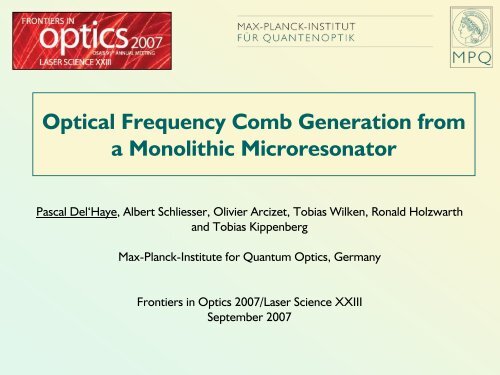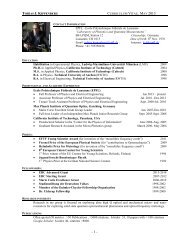Optical Frequency Comb Generation from a Monolithic ... - K-LAB
Optical Frequency Comb Generation from a Monolithic ... - K-LAB
Optical Frequency Comb Generation from a Monolithic ... - K-LAB
Create successful ePaper yourself
Turn your PDF publications into a flip-book with our unique Google optimized e-Paper software.
<strong>Optical</strong> <strong>Frequency</strong> <strong>Comb</strong> <strong>Generation</strong> <strong>from</strong><br />
a <strong>Monolithic</strong> Microresonator<br />
Pascal Del‘Haye, Albert Schliesser, Olivier Arcizet, Tobias Wilken, Ronald Holzwarth<br />
and Tobias Kippenberg<br />
Max-Planck-Institute for Quantum Optics, Germany<br />
Frontiers in Optics 2007/Laser Science XXIII<br />
September 2007
<strong>Frequency</strong> <strong>Comb</strong>s<br />
Kerr lens mode-locked laser:<br />
chirped mirror<br />
f n<br />
=<br />
CE<br />
S. T. Cundiff. Phase stabilization of ultrashort optical pulses. Journal Of Physics D-Applied Physics, 35(8):R43–R59, April 2002.<br />
2<br />
P. Del‘Haye – Kerr <strong>Comb</strong>s – FIO 2007<br />
f<br />
pump<br />
Pulse train in time domain<br />
Equidistant lines in frequency<br />
domain.<br />
+ n⋅<br />
Hz<br />
f<br />
rep<br />
Ti:Al 2 O 3<br />
Aperture<br />
n = Integer number<br />
outcoupling mirror<br />
cavity roundtrip time τ<br />
= 1/<br />
frep<br />
pulse train<br />
2π ⋅ frep<br />
=
Toroid Microcavities on-a-Chip<br />
• <strong>Optical</strong> whispering gallery modes with very<br />
long photon lifetimes:<br />
Q>10 8 can be obtained<br />
Photon lifetimes of several 100 ns<br />
Finesse in excess of 1,000,000<br />
• Small mode volume<br />
• Silicon compatible<br />
Built on a silicon wafer<br />
Integration with other function<br />
P. Del‘Haye – Kerr <strong>Comb</strong>s – FIO 2007<br />
Vahala Group<br />
Armani, Kippenberg, Spillane, Vahala, Nature 421, 925-928 (2003).<br />
3
Toroidal Microcavities<br />
Fabrication using standard microfabrication techniques<br />
silica<br />
silicon<br />
(a) (b) (c)<br />
2 μm silica layer<br />
on silicon wafer<br />
CO 2 laser beam<br />
P. Del‘Haye – Kerr <strong>Comb</strong>s – FIO 2007<br />
Silica pads on silicon wafer after<br />
lithography, HF-etching<br />
CO 2 laser assisted reflow<br />
Wavelength λ=10.6 μm<br />
absorbed by silica,<br />
silicon transparent<br />
Free standing silica discs after<br />
XeF 2 dry etching<br />
Ultra-high-Q: Q=ωτ up to 6x10 8<br />
4
Tapered Fiber Coupling<br />
Taper-microcavity junction exhibits<br />
extremely high ideality (coupling losses<br />
Parametric Oscillations<br />
Degenerate fourwave<br />
mixing:<br />
ω p<br />
ω p<br />
P. Del‘Haye – Kerr <strong>Comb</strong>s – FIO 2007<br />
ω s<br />
ω i<br />
Annihilation of two pump photons ω p and emission of signal and<br />
idler photon (ω s and ω i). Threshold powers ~100 μW<br />
1) Kippenberg, T. J.; Spillane, S. M. & Vahala, K. J., Physical Review Letters, 2004, 93, 083904<br />
2) Savchenkov, Matsko, Strekalov, Mahageg, Ilchenko, Maleki, PRL, 2004, 93, 243905<br />
ω i<br />
The process can cascade with nondegenerate<br />
four-wave mixing:<br />
ω p<br />
ω s<br />
ωi<br />
ω p<br />
ω s<br />
ω i ’<br />
Silica Resonator (1)<br />
CaF 2 Resonator (2)<br />
6
Generating <strong>Comb</strong>s<br />
P. Del‘Haye – Kerr <strong>Comb</strong>s – FIO 2007<br />
(silica)<br />
Modespacing = 1 THz, 70 μm-diameter cavity<br />
70 μm<br />
More than 130 lines, pump power 500 mW<br />
177-μm-diameter cavity<br />
- Up to 500 nm spanning combs observed.<br />
- Conversion efficiencies of more than 80 % can be achieved!<br />
P.Del’Haye, A. Schliesser, O. Arcizet, T. Wilken, K. Vahala, R. Holzwarth, T. J. Kippenberg (arXiv:0708.0611)<br />
7
Cold Microcavity Modes<br />
The microcavity modes are not expected to be a priori equidistant due to dispersion.<br />
P. Del‘Haye – Kerr <strong>Comb</strong>s – FIO 2007<br />
ω FSR1<br />
ω FSR2<br />
Δω FSR = ω FSR2 - ω FSR1<br />
SPM<br />
XPM XPM<br />
Solutions:<br />
- Nonlinear: Modes can be pulled equidistant by self-phase modulation and cross-phase modulation. 1)<br />
- Linear: Dispersion compensation<br />
1) Kippenberg, T. J.; Spillane, S. M. & Vahala, K. J., Physical Review Letters, 2004, 93, 083904<br />
ω<br />
ω<br />
8
Microcavity Dispersion<br />
Dispersion contributions:<br />
Waveguide Dispersion Δω FSR < 0:<br />
Material Dispersion Δω FSR > 0 for λ > 1300 nm:<br />
For wavelengths > 1300 nm, material and waveguide dispersion can be compensated!<br />
P. Del‘Haye – Kerr <strong>Comb</strong>s – FIO 2007<br />
9
Dispersion Measurement<br />
Utilizing a fiber laser frequency comb to measure the FSR of a microcavity.<br />
Distance between cold microcavity modes:<br />
P. Del‘Haye – Kerr <strong>Comb</strong>s – FIO 2007<br />
f offset<br />
Δf<br />
= f + n ⋅<br />
offset<br />
n = Number of fiber comb lines between two microcavity resonances<br />
f<br />
rep<br />
10
Dispersion Measurement<br />
P. Del‘Haye – Kerr <strong>Comb</strong>s – FIO 2007<br />
ω FSR1<br />
ω FSR2<br />
1577 nm<br />
ω FSR3<br />
1516 nm<br />
ω FSR4<br />
Accumulated dispersion in a 70 μm diameter microcavity<br />
over a wavelength range of 61 nm [1577nm…1516nm]<br />
ω<br />
Dispersion of a cold toroidal<br />
microcavity: ~3 MHz/FSR<br />
11
Microcavity combs?<br />
P. Del‘Haye – Kerr <strong>Comb</strong>s – FIO 2007<br />
Are the lines equidistant?!<br />
12
<strong>Frequency</strong> combs for metrology<br />
<strong>Frequency</strong> comb lines<br />
with known frequencies<br />
(Mode spacing ~ 100 MHz)<br />
Hz<br />
P. Del‘Haye – Kerr <strong>Comb</strong>s – FIO 2007<br />
Unknown optical frequency<br />
ν N-2<br />
ν N-1<br />
ν 0<br />
ν N<br />
Radio frequency beat note with νB = νN - ν0 The beat note frequency can be measured with radio<br />
frequency counters.<br />
ν N+1<br />
ν<br />
13
Equidistance of <strong>Comb</strong> Lines<br />
Superimposing two frequency combs...<br />
Multi-Heterodyne 1) Measurement:<br />
ω beat1<br />
P. Del‘Haye – Kerr <strong>Comb</strong>s – FIO 2007<br />
ω beat2<br />
Fiber Laser <strong>Comb</strong><br />
1 THz<br />
ω beat3<br />
ω beat1 ω beat2 ω beat3<br />
100 MHz<br />
optical frequency (THz)<br />
radio frequency (MHz)<br />
Kerr <strong>Comb</strong><br />
RF beat notes<br />
Fiber Laser<br />
<strong>Comb</strong> Line<br />
(100 MHz spacing)<br />
Kerr <strong>Comb</strong> Line<br />
(1 THz spacing)<br />
Beat Note<br />
An equidistant beat note spectrum can be generated by<br />
superimposing two equidistant combs.<br />
Photodiode<br />
1) Schliesser, Brehm, Keilmann, van der Weide, Optics Express, 13, 1929 (2005)<br />
14
Equidistance of <strong>Comb</strong> Lines<br />
<strong>Optical</strong> Domain Radio <strong>Frequency</strong> Domain<br />
Beat note spectrum:<br />
Fiber Laser <strong>Comb</strong><br />
⊗<br />
Kerr <strong>Comb</strong><br />
P. Del‘Haye – Kerr <strong>Comb</strong>s – FIO 2007<br />
=<br />
Kerr lines are proved to be<br />
equidistant to a level of<br />
2 kHz<br />
200 THz<br />
=<br />
1 x 10 -13<br />
First demonstration of frequency comb generation in a monolithic microcavity!<br />
15
Counting the sidebands<br />
P. Del‘Haye – Kerr <strong>Comb</strong>s – FIO 2007<br />
<strong>Frequency</strong> Counter<br />
16
Counting the sidebands<br />
P. Del‘Haye – Kerr <strong>Comb</strong>s – FIO 2007<br />
σ<br />
A<br />
Accuracy relative to the optical<br />
carrier:<br />
5.5 mHz / 200 THz = 3 · 10 -17<br />
=<br />
⋅<br />
1<br />
2(<br />
N −1)<br />
∑ − N 1<br />
i=<br />
1<br />
( y<br />
+ − i 1<br />
y<br />
i<br />
)<br />
2<br />
Allan deviation:<br />
Measure of the relative accuracy<br />
that can be obtained with a certain<br />
gate time.<br />
P.Del’Haye, A. Schliesser, O. Arcizet, T. Wilken, K. Vahala, R. Holzwarth, T. J. Kippenberg (arXiv:0708.0611)<br />
17
Thermal drift of the modespacing<br />
P. Del‘Haye – Kerr <strong>Comb</strong>s – FIO 2007<br />
Kerr comb modes<br />
Stabilized reference<br />
comb modes<br />
ω<br />
18
Kerr <strong>Comb</strong> Actuators<br />
Two control variables to define all lines of a frequency comb:<br />
Modelocked Laser:<br />
Carrier envelope offset frequency f CEO<br />
Repetition rate f rep<br />
Pump frequency<br />
control<br />
P. Del‘Haye – Kerr <strong>Comb</strong>s – FIO 2007<br />
Pump power<br />
control<br />
pump<br />
beat<br />
Microcavity comb:<br />
Pump frequency f P<br />
Mode spacing Δν<br />
Controlled by pump power<br />
sideband<br />
beat<br />
19
Stability of the Kerr <strong>Comb</strong> Lock<br />
P. Del‘Haye – Kerr <strong>Comb</strong>s – FIO 2007<br />
Gatetime 1s<br />
Modespacing<br />
Locked with<br />
microcavity<br />
pump power<br />
Pump <strong>Frequency</strong><br />
Standard lock of<br />
a diode laser to a<br />
reference laser<br />
20
Conclusion<br />
Summary<br />
• <strong>Frequency</strong> combs spanning 500 nm have<br />
been generated<br />
• Equidistance has been proved to a level<br />
of 7.3x10 -18<br />
• Locking has been demonstrated<br />
Advantages<br />
• <strong>Monolithic</strong> on-chip design<br />
• High power per comb line<br />
(1 mW/combline can be easily achieved)<br />
• High repetition rate (>100 GHz)<br />
Single comb lines accessible<br />
Future Research<br />
• Increase cavity diameter for mode<br />
spacings in the microwave domain<br />
• Generate octave spanning spectra<br />
• Time domain behaviour?!<br />
P. Del‘Haye – Kerr <strong>Comb</strong>s – FIO 2007<br />
Future Applications<br />
• Pulse shaping<br />
• Spectrometer calibration<br />
• Multi-channel<br />
telecommunication<br />
21
Funding<br />
P. Del‘Haye – Kerr <strong>Comb</strong>s – FIO 2007<br />
Max Planck Generalverwaltung via an<br />
Independent Max Planck Junior Research Group<br />
MPQ<br />
Marie Curie Reintegration Grant (IRG)<br />
Marie Curie Excellence Grant (EXT)<br />
NIM Initiative<br />
Nano-Science European Research Area<br />
22
Acknowledgments<br />
Tobias Kippenberg<br />
Group Leader<br />
Georg Anetsberger<br />
(Diplom)<br />
Mechanical Dissipation<br />
P. Del‘Haye – Kerr <strong>Comb</strong>s – FIO 2007<br />
Olivier Arcizet<br />
(Postdoc)<br />
Remi Riviere<br />
(PhD)<br />
Cooling Project<br />
Jens Dobrindt<br />
(Diplom)<br />
Cooling Theory<br />
Albert Schliesser<br />
(PhD)<br />
Cavity Cooling, combs<br />
Xiaoqing Zhou<br />
(PhD)<br />
Coulomb Cooling<br />
Remi Riviere<br />
(PhD)<br />
Cavity Cooling<br />
Yang Yang<br />
(PhD)<br />
Coulomb Cooling<br />
Thank you for your attention!<br />
Bastian Schroeter<br />
(Diplom)<br />
Biochemical Sensing<br />
www.mpq.mpg.de/k-lab<br />
23
End<br />
P. Del‘Haye – Kerr <strong>Comb</strong>s – FIO 2007<br />
24







